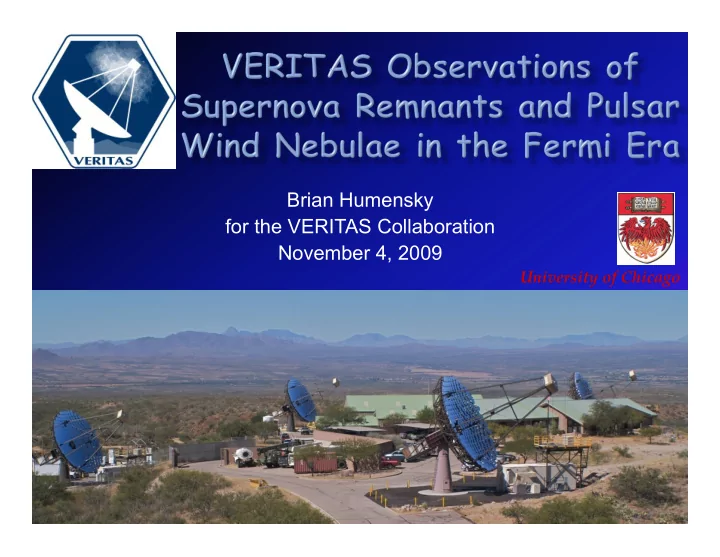

Brian Humensky for the VERITAS Collaboration November 4, 2009 University of Chicago
T1 Instrument design: Sep 2009 Four 12-m telescopes, 3.5° FoV FLWO, Mt. Hopkins, Az (1268m) Fully operational Sept 2007 Performance: 3-level trigger (250 Hz rate) ~ 800 hrs/yr dark time, ~ 200 hrs/yr moon time Sensitivity: Energy threshold ~150 GeV (zenith) 1% Crab < 50 hours (before T1 move) Energy resolution ~ 15-20 % 1% Crab < 30 hours (after T1 move) Angular resolution ~ 0.1° See poster by J. Perkins VERITAS T1 Relocation
http://tevcat.uchicago.edu 25 Source Detections in 6+ source classes, at least 10 in the Galactic Plane
“Cousin of the Crab” X-ray jet/torus, no thermal shell Age ~ 2900 years E-dot = 1.2 × 10 37 erg/s Distance ~ 6.2 kpc Also, Nearby Molecular Cloud: TeV PSF Lu et al. 2002 (Chandra/ACIS) Leahy et al. 2008 (FCRAO)
Hint of signal in 2007 moonlight data. 2008 follow-up yields a 7- σ detection in 31 hours Location compatible with pulsar Consistent with point source. Power-law spectrum: Index: 2.40 ± 0.24 stat ± 0.3 sys Flux (> 1 TeV) ~ 2.5% Crab L γ / E-dot ~ 0.15% Similar to other young TeV PWNe, eg G0.9+0.1, Kes 75 VHE γ -rays from freshly injected electrons? Enhancement from interaction with molecular cloud? Acciari et al. (2009), in prep. See poster by E. AliuVERITAS Obs . of PWNe
1420 MHz: Effelsberg (Kothes et al.) Energetic pulsar + wind nebula discovered in the error box of source 3EG J2227+6122. Age ~ 10,000 years E-dot = 2.2 × 10 37 erg/s Likely part of the larger SNR G106.3+2.7 Distance ~ 800 pc (Kothes et al) On Fermi/LAT Bright Source Boomerang PWN List MILAGRO: Extended emission at ~35 TeV
Observations made in 2008 Excess Map resolve TeV emission overlapping the radio shell of G106.3+2.7 7.3 σ detection in 33 hours (6.0 σ post-trials) TeV emission is extended Spans a 0.4° × 0.6° region Peak is 0.4° away from PSR Overlaps with region of high CO density Black – Radio (DRAO) Circle – FGST Error Box Dot – Pulsar Position Purple - 12 CO Emission (FCRAO) Yellow star – 1AGL J2231+6109 Acciari et al. 2009, ApJ 703 L6. See poster by E. AliuVERITAS Obs . of PWNe
Energy Spectrum Integrate over 0.32° radius centered on emission peak Well fit by a pure power law Index: 2.3 ± 0.3 stat ± 0.3 sys Flux (> 1 TeV) ~ 5% Crab Extension of spectrum is consistent within errors with Milagro point at 35 TeV Spectrum may favor hadronic origin?
Shell interacting with massive cloud Age ~20-30 kyr, 0.75 º diameter PWN at southern edge of • Green – Radio shell • Red – Optical • Blue – X-rays Discovered in GeV by EGRET Now AGILE, Fermi Discovered in TeV in 2007 by MAGIC (5.7 σ in 29 hrs) by VERITAS (7.1/6.0 σ pre/ post-trials in 15.9 hrs) Troja et al. (2006)
2-D Gaussian profile fit: 2-D Gaussian pr ofile fit: Centr Centroid: 06 16.9 +22 32.4 ± 0.03º oid: 06 16.9 +22 32.4 ± 0.03º stat stat ± 0.07º ± 0.07º sys sys Extension: σ ~ 0.16º ± 0.03º Extension: ~ 0.16º ± 0.03º stat stat ± 0.04º ± 0.04º sys sys TeV emission may be CR-induced pion production in cloud associated with the pulsar wind Red: Optical (DSS) nebula to the south Green: CO (Lee et al. 2010, in prep.) GeV and TeV emission spatially Yellow: VERITAS significance (4, 6 σ ) separated? (both extended) Total live time: 37.9 hrs. Broad-band morphological evolution distinguishes between 8.3 σ peak significance pre- scenarios (not all PWN) trials Window into propagation / Power-law fit 0.3 – 2 TeV: diffusion of Cosmic Rays in Index: 2.99 ± 0.38 stat ± 0.3 sys interstellar medium Flux (> 300 GeV) ~ 3.2% Crab Acciari et al. 2009, ApJ 698 L133
Young (~330 yr), well studied shell-type SNR Distance ~3.4 kpc 5-arcmin diameter Comparable to TeV PSF Discovered in TeV by HEGRA (232 hrs, 5 σ ), confirmed by MAGIC (47 hrs, 5.3 σ ) Stage et al. 2006 (Chandra, 7.3’ by 6.4’)
VERITAS: 22 hr data in 2007, 8.3 σ Consistent with point source Solid: VERITAS Dashed: HEGRA Dotted: MAGIC Index: 2.61 ± 0.24 stat ± 0.2 sys Flux (> 1 TeV) ~3.5% Crab No sign of a cut-off at high energy. Fermi spectrum connects at lower energy Electrons or hadrons? Acciari et al. 2009, submitted
SNR G54.1+0.3: Young TeV PWN with a possible MC interaction Detailed MWL modeling will be valuable! SNR G106.3+2.7: Extended TeV source – associated with PWN or SNR/MC interaction? IC 443: Classic SNR / MC interaction system Wonderful laboratory to explore cosmic-ray interaction / diffusion Cassiopeia A: Young, nonthermal X-ray SNR VHE spectrum is a power law to 5 TeV See also A. Weinstein VERITAS Survey of the Cygnus Region of the Galactic Plane E. Aliu VERITAS Observations of Pulsar Wind Nebulae (poster) GeV / TeV synergy is only just beginning!
Recommend
More recommend